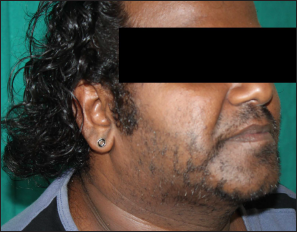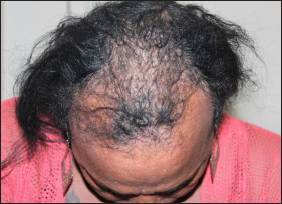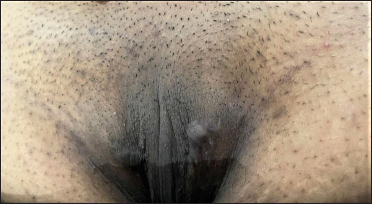Translate this page into:
Dermatologic care of the lesbian, gay, bisexual and transgender community of India
Corresponding author: Dr. Surya Ravindran, Cosmohome Skin Clinic Nilambur, Kerala, India. surya_ravi2011@hotmail.com
-
Received: ,
Accepted: ,
How to cite this article: Ravindran S, Nazeer M, Criton S. Dermatologic care of the lesbian, gay, bisexual and transgender community of India. Indian J Dermatol Venereol Leprol 2023;89:416-20.
Abstract
Background
In the Indian subcontinent, the lesbian, gay, bisexual, transgender, and queer community, commonly referred to as the third gender or transgender, is expected to exceed one million by 2030. Data on dermatologic conditions of the transgender population is deficient.
Aims
This study aimed to identify the common dermatological concerns and dermatologic procedures of the lesbian, gay, bisexual, transgender, and queer community of India.
Methods
This cross-sectional survey analysed the transgender participants of a non-institutionalised population in India via health camps that included 51 adult participants who self-identified as trans men and trans women.
Results
This study included 51 participants aged 20-49 years, of which the majority (94%) were trans women. The common dermatological problems were terminal hairs over the face, beard distribution, androgenetic alopecia, scars of gender-affirming surgeries, facial melanosis with topical steroid damaged skin and the need for facial feminisation procedures among trans women, while trans men had testosterone-related acne, androgenetic alopecia. Overall, 40.6% of participants reported dissatisfaction with one or more of their body parts. Laser hair removal was the most common gender-affirming dermatologic procedure.
Conclusion
This study provides an essential overview of the common dermatological conditions and procedures in the Indian lesbian, gay, bisexual, transgender, and queer community. Lesbian, gay, bisexual, transgender, and queer persons have insufficient access to dermatological services due to inadequate exposure and fear of discrimination. Even though transgender patients also present with similar dermatologic conditions as the general population, they have distinct cosmetic and treatment concerns during the period of transition owing to hormone-related or surgery-related changes. Addressing these challenges through enhancing dermatology residency training programs should be the focus of tomorrow.
Limitations
Considering convenience sampling and representative bias, further studies need to be conducted involving multiple study locations and larger sample sizes.
Keywords
LGBT
LGBT Dermatology
Transgender
Plain Language Summary
A transgender is defined as a person whose body identity does not correspond to the gender assigned at birth. In 2014, the Supreme Court of India pronounced a landmark judgement recognising transgenders as a third gender and today they form a significant group in our society with over 2.5 million population in India. With such a large number of transgenders, effort should be made to understand their health concerns, as they differ from the general community in various aspects. There is an intake of various exogenous hormones including progesterone/oestrogen and testosterone in male to female transgenders and female to male transgenders respectively and sex reconstruction surgeries alter the epidermis, dermis, pilosebaceous apparatus and sebum production. This study was conducted by us to identify the dermatological concerns of the transgender community. We conducted a cross-sectional study in dermatology health camps for transgenders living in South India. We found that transgenders faced dermatological conditions like patterned hair loss, post-surgical scars of sex re-assignment surgeries and commonly underwent laser hair removal over the face and chest as the first step towards gender affirmation, especially in trans women. We concluded transgenders, even though a minority have significant dermatological concerns and more research is warranted.
Introduction
Even though there are no updated statistics available, the 2011 Indian census identified the total population of adult transgenders and transgender children to be around 4.88 lakh and 55,000, respectively.1 The lesbian, gay, transgender, and queer or gender minority community makes up 2.7-5.3% of the U.S population.2 This group experiences barriers to healthcare due to prejudice, stigmatisation and lack of understanding of their specific concerns by health professionals.
Even though the term lesbian, gay, bisexual, transgender, and queer is broad, a transgender is defined as a person who does not identify with their gender assigned at birth.3 Trans man is a transgender person who has transitioned from female to male while in trans women, the transition is from male to female.3 During this transition, they undergo a multitude of changes attributable to both the effects of hormonal intake and repeated sex reassignment surgeries which include changes in the epidermis, dermis, pilosebaceous apparatus and sebum production,4
Several studies have identified dermatologic concerns of the lesbian, gay, bisexual, transgender and queer/sexual and gender minority patients in the Caucasian population.4-8 These have established prevalence data for the most common diseases in the African-American transgender community. There is a paucity of data on the Indian lesbian, gay, bisexual, transgender and queer communities. Because this minority sub-group is booming and is more likely to experience discrimination within our healthcare system, it is important to assess the healthcare disparities and fill some of these gaps in the data.9
Gender transitioning is a multi-step process that involves dermatologists, endocrinologists, surgeons and psychiatrists. With the increasing number of transgender patients transitioning, dermatologists play an essential role in the medical and aesthetic care of transgender patients.5
Materials and Methods
We conducted a cross-sectional study by organising dermatology health camps for the transgender community living in South India. In order to get a more representative sample, word-of-mouth spread was encouraged with telephonic contact via transgender organisations. Participants had to be at least 18 years old, living in India, give informed consent, and identify themselves as transgender people. A total of 51 self-identified transgender participants, aged 20-49 years, agreed to partake in this cross-sectional study. The sample size calculation was done based on the incidence of the transgender population in India. Participation in the study involved completing a single 20-item survey questionnaire. The Institutional review board approved the study. All survey questions were developed to maximise their clarity and participant understanding. The survey was not pretested in a pilot sample; however, an investigator was present at all times to answer questions. After participants had provided informed consent, they were interviewed by the investigator using the survey questionnaire. They were allowed to ask questions of a supervising investigator if they needed clarification on any element of the questionnaire. It took participants approximately 20-30 minutes to answer the questionnaire. Specific components of the survey included demographic information, common hormonal supplements, common surgeries and procedures, skin complaints, participants perception of their appearance, dermatologic care-seeking patterns and barriers to receiving dermatologic care, and body image. The content and validity of the questions about body image were checked and verified by informal discussions with three experts (Dermatology, Psychiatry and Psychology). Descriptive statistics, including means and medians for continuous variables and frequency tables for categorical variables, were generated using Excel (Microsoft Corp) and SPSS 22 software.
Results
Sample characteristics
A total of 51 self-identified transgender participants, aged 20-49 years, agreed to partake in this cross-sectional study [Table 1]. The majority (94%) of the study subjects were trans women.
| Gender description Trans man Trans woman |
3 (6%) 48 (94%) |
|---|---|
| Age in years 20-30 30-40 40-50 |
40 10 1 |
| Highest level of education Middle school High school College degree |
38 11 2 |
| Employment Makeup artists Tailoring Dance artists Metro rail workers Unemployed Commercial sex workers |
14 13 12 2 8 2 |
| Monthly household income level 5000-7000 7000-10,000 10,000 and above |
12 36 3 |
Hormonal and surgical therapy
Nearly 92.1% of participants were on hormonal therapy that included oestradiol valerate (47.05%), anti-androgens like spironolactone (39%) in trans women, and intra-muscular testosterone injections in trans men prescribed by endocrinologists (5.8%) [Table 2]. The most common gender-affirming procedure (surgical or dermatological) performed was laser hair removal (64%) followed by breast augmentation surgeries (53%) in trans women, followed by genital affirmation surgery to remove the testes (orchiectomy), vaginoplasty (to create a neovagina), (26.4%) or a combination in trans women. In trans men, the most common procedure was chest masculinisation surgery.
|
Hormonal intake n = 51(%)* |
|||
|
Trans women: Oral estradiol valerate Oral aldactone Combination of estradiol valerate and aldactone |
24 (47%) 20 (39%) 20 (39%) |
||
|
Trans men: Testosterone Intramuscular injections |
3 (5.8%) |
||
|
Common procedures/surgeries done: n = 51(%)* |
|||
| Trans women: | Trans men: | ||
| Laser hair removal Breast augmentation surgery Orchiectomy with vaginoplasty Neurotoxins/fillers for facial feminisation |
33 (64.7%) 27 (53%) 13 (26.4%) 6 (11.7%) |
Chest masculinisation surgery: | 2 (67%) |
*Most of them had more than one procedure done and were on multiple hormones
Dermatological concerns
Of the dermatological concerns listed [Table 3], laser hair removal for terminal hairs in the face [Figures 1a and b] emerged as the most likely reason for consulting a dermatologist followed by androgenetic alopecia [Figure 2], previous scars of gender-affirming surgeries, [Figure 3], facial melanosis with topical steroid damaged skin and the need for facial feminisation procedures in trans women while trans men reported testosterone-related acne.
| Dermatological concerns of the Transgender population | |||
|---|---|---|---|
| Trans women | n = 48 (%) | Trans men | n = 3 (%) |
| Terminal hair over face and chest | 38 (79.1%) | Androgenetic alopecia | 3 (100%) |
| Androgenetic alopecia | 27 (53%) | Post-surgical scars of gender affirming surgeries | 2 (67%) |
| Post-surgical scars of gender-affirming surgeries | 30 (61%) | Testosterone induced acne | 1 (33.3%) |
| Facial melanosis and topical steroid damaged skin | 10 (20.8%) | ||
| Facial feminisation procedures | 8 (16.6%) | ||

- Presence of terminal hair over face and beard region after one month of anti-androgen therapy (estradiol valerate and spironolactone)

- Presence of shadowing of terminal hair over face and beard region after six months of anti-androgen therapy (estradiol valerate and spironolactone) and one sitting of laser hair removal

- Moderate to severe androgenetic alopecia in a trans woman

- Postoperative result of orchiectomy with vaginoplasty in a transgender woman with surgical scars and keloid over the suture site
Patterns of dermatologic care-seeking
A total of 90.1% of participants reported having sought help for a skin concern in the past. However, only 15.6% of participants had specifically consulted a dermatologist. Others frequently visited beauticians, endocrinologists, plastic surgeons, and psychiatrists for skin concerns. Of those reporting a past visit to a dermatologist, only three participants currently see a dermatologist regularly. Participants were also questioned whether they had experienced any barriers in scheduling an appointment; 82.7% reported difficulties attaining dermatologic care. Overall, 40.6% of participants reported dissatisfaction with one or more of their body parts. Furthermore, 35.2% of participants did believe that if physical appearance and dermatological concerns are alleviated, they would be better accepted in society.
Discussion
In the present study population, the majority were trans women (94%), in contrast to the previous studies in the American population that had more trans men (63%) participants.6
Previous studies in American populations have identified testosterone-induced acne and androgenetic alopecia in trans men5-8 as the most common dermatological concern.
Since there were only three trans men in the study, most of our findings relate to dermatological concerns of trans women [Table 3]. The incidence of trans men is less in India as they are a highly invisible and marginalised gender minority.10
In our study, laser hair removal in trans women was the commonest dermatological procedure that correlated with other studies among trans women.5 Even though facial hair may reduce within three months of hormonal intake of oestrogen, it does not eliminate the terminal hair in the beard region, making laser hair removal the first step in the gender transitioning process of a trans woman.5
Only 21.7% of participants had consulted a dermatologist. They conveyed they avoided dermatology clinics due to difficulty revealing their sex status at hospital registration counters or were apprehensive of mockery or ill-treatment by hospital staff, fear of surgical scars, or outcome of the procedure, low income, etc. The use of non-prescription topical steroids was also significant associated with topical steroid damaged skin.
The prevalence of HIV infection in the United States among transgender women and men accounted for 14% and 3.2%. The frequencies of HIV, sexually transmitted diseases, and malignancies (neovaginal condyloma/neovaginal carcinoma/melanoma) are high in the transgender population of the West.11-13 A systematic review conducted among 11066 lesbian, gay, bisexual, transgender and queer members worldwide reported the prevalence of HIV to be 19.1%.12 However, none of our participants directly reported a history of HIV/sexually transmitted disease, but on further questioning about treatment history, 25% admitted they were on antiretroviral medications. Dermatologists must be aware of the prevalence of HIV in this group during examination and treatment and follow universal precautions. They can educate patients and refer them to health care providers for pre-exposure prophylaxis and management.
Androgenetic alopecia was a major dermatological problem for most of our participants. Due to the impact of gender-affirming hormones like testosterone in trans men and oestrogen and anti-androgens in trans women hair growth cycle is directly impacted. Even though the exact prevalence of androgenetic alopecia in gender minorities compared to the general population is unknown, many studies have highlighted it.14,15
In the present study, 40.6% of trans women reported dissatisfaction with one or more of their body parts. It is well reported that transgender women and men report a lower quality of life and mental health compared to the general population.16-18 Minimally invasive gender-affirming aesthetic procedures like neurotoxins, dermal fillers and threads by a dermatologist may enhance their satisfaction with facial appearance or feminisation and quality of life.
Limitations
The present study had two limitations. Although the camp attracted trans genders from several parts of south India, this sample may not represent the broader population in India. Convenience sampling creates the possibility of selection bias. Therefore, future studies involving multiple study locations and larger sample sizes may provide more representative data. The second limitation of the study was that the questionnaire was not pre-tested in a pilot sample.
Conclusion
In summary, this study summarises the most common dermatological problems and concerns of the Indian transgender population. It highlights that laser hair removal is the commonest procedure and one of the first steps involved in transitioning. Although the prevalence of skin diseases shows similarities with American studies across all age groups, important sex-related differences in the frequencies of skin disorders were apparent [Table 4]. Even though they were a neglected healthcare group in the past, instituting transgender clinics and inclusion in dermatology curriculum can alleviate healthcare disparities. We hope that this article is the first of many steps in researching and understanding the dermatologic care needed for the transgender population in India.
| Comparison studies | Ginsberg BA et al.5 | Current study |
|---|---|---|
| Population | American | Indian |
| Gender distribution | Trans men > Trans woman | Trans woman > Trans men |
| Age group in years | 29-45 | 20-40 |
| Prior health care provider for dermatological concerns | Plastic surgeons/dermatologist | Non-medical/endocrinologists |
| Commonest procedure | Laser hair removal (Transwoman) | Laser hair removal |
| Body image concerns | Facial features and chest | Facial features and scalp hair |
Acknowledgement
We acknowledge the contribution of our colleagues Venma Mampilly, Manjunath Madathil, Shruti Rathish, Arathy Jerald, and Haseena Hassan CK from Amala Institution of Medical Sciences, Thrissur.
Declaration of patient consent
Institutional Review Board (IRB) permission obtained for the study.
Financial support and sponsorship
Nil.
Conflict of interest
There are no conflicts of interest.
References
- The Office of the Registrar & Census Commissioner, India, Ministry of Home Affairs, Government of India. 2011. [Last accessed on 2018 Aug 11]. Available from: http://www.censusindia.gov.in/
- [Google Scholar]
- State of the States Gallup Politics. 2017. Available at: https://news.gallup.com/poll/203513/vermont-leads-states-lgbt-identification.aspx
- [Google Scholar]
- Guidelines for the primary and gender-affirming care of transgender and gender nonbinary people: introduction to the guidelines. Available at: http://transhealth.ucsf.edu/pdf/Transgender-PGACG-6-17-16
- [Google Scholar]
- Paucity of lesbian, gay, bisexual, and transgender health-related content in the basic dermatology curriculum. JAMA Dermatol. 2018;154:614-5.
- [CrossRef] [PubMed] [Google Scholar]
- A potential role for the dermatologist in the physical transformation of transgender people: A survey of attitudes and practices within the transgender community. J Am Acad Dermatol. 2016;74:303-8.
- [CrossRef] [PubMed] [Google Scholar]
- Short-and long-term clinical skin effects of testosterone treatment in trans men. J Sex Med. 2014;11:222-9.
- [CrossRef] [PubMed] [Google Scholar]
- Severe acne in female-to-male transgender patients. JAMA dermatol. 2015;151:1260-1.
- [CrossRef] [PubMed] [Google Scholar]
- Dermatologic care of the transgender patient: Highlighting a practice gap within dermatology. Dermatol Online J. 2016;22 13030/qt01j5z8ps
- [PubMed] [Google Scholar]
- Prevalence and health implications of anti-gay discrimination: A study of black and white women and men in the CARDIA cohort. Coronary artery risk development in young adults. Int J Health Serv. 1997;27:157-76.
- [CrossRef] [PubMed] [Google Scholar]
- Worldwide burden of HIV in transgender women: A systematic review and meta-analysis. The Lancet Infect Dis. 2013;13:214-22.
- [CrossRef] [PubMed] [Google Scholar]
- Gender abuse, depressive symptoms, and HIV and other sexually transmitted infections among male-to-female transgender persons: A three-year prospective study. Am J Public Health. 2013;103:300-7.
- [CrossRef] [PubMed] [Google Scholar]
- Short- and long-term clinical skin effects of testosterone treatment in trans men. J Sex Med. 2014;11:222-9.
- [CrossRef] [PubMed] [Google Scholar]
- Cross-sex hormone therapy in trans persons is safe and effective at short-time follow-up: Results from the european network for the investigation of gender incongruence. J Sex Med. 2014;11:1999-2011.
- [CrossRef] [PubMed] [Google Scholar]
- Is hormonal therapy associated with better quality of life in transsexuals? A cross-sectional cross-sectional study. J Sex Med. 2012;9:531-41.
- [CrossRef] [PubMed] [Google Scholar]
- Quality of life and sexual health after sex reassignment surgery in transsexual men. J Sex Med. 2011;8:3379-88.
- [CrossRef] [PubMed] [Google Scholar]
- Quality of life in transitioned trans persons: A retrospective cross-sectional cohort study. Biomed Res Int. 2018;2018:8684625.
- [CrossRef] [PubMed] [Google Scholar]






